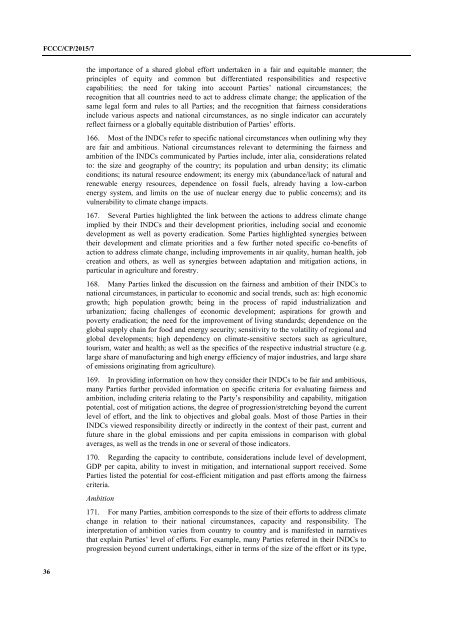FCCC/CP/2015/7
1PYuHQM
1PYuHQM
You also want an ePaper? Increase the reach of your titles
YUMPU automatically turns print PDFs into web optimized ePapers that Google loves.
<strong>FCCC</strong>/<strong>CP</strong>/<strong>2015</strong>/7<br />
the importance of a shared global effort undertaken in a fair and equitable manner; the<br />
principles of equity and common but differentiated responsibilities and respective<br />
capabilities; the need for taking into account Parties’ national circumstances; the<br />
recognition that all countries need to act to address climate change; the application of the<br />
same legal form and rules to all Parties; and the recognition that fairness considerations<br />
include various aspects and national circumstances, as no single indicator can accurately<br />
reflect fairness or a globally equitable distribution of Parties’ efforts.<br />
166. Most of the INDCs refer to specific national circumstances when outlining why they<br />
are fair and ambitious. National circumstances relevant to determining the fairness and<br />
ambition of the INDCs communicated by Parties include, inter alia, considerations related<br />
to: the size and geography of the country; its population and urban density; its climatic<br />
conditions; its natural resource endowment; its energy mix (abundance/lack of natural and<br />
renewable energy resources, dependence on fossil fuels, already having a low-carbon<br />
energy system, and limits on the use of nuclear energy due to public concerns); and its<br />
vulnerability to climate change impacts.<br />
167. Several Parties highlighted the link between the actions to address climate change<br />
implied by their INDCs and their development priorities, including social and economic<br />
development as well as poverty eradication. Some Parties highlighted synergies between<br />
their development and climate priorities and a few further noted specific co-benefits of<br />
action to address climate change, including improvements in air quality, human health, job<br />
creation and others, as well as synergies between adaptation and mitigation actions, in<br />
particular in agriculture and forestry.<br />
168. Many Parties linked the discussion on the fairness and ambition of their INDCs to<br />
national circumstances, in particular to economic and social trends, such as: high economic<br />
growth; high population growth; being in the process of rapid industrialization and<br />
urbanization; facing challenges of economic development; aspirations for growth and<br />
poverty eradication; the need for the improvement of living standards; dependence on the<br />
global supply chain for food and energy security; sensitivity to the volatility of regional and<br />
global developments; high dependency on climate-sensitive sectors such as agriculture,<br />
tourism, water and health; as well as the specifics of the respective industrial structure (e.g.<br />
large share of manufacturing and high energy efficiency of major industries, and large share<br />
of emissions originating from agriculture).<br />
169. In providing information on how they consider their INDCs to be fair and ambitious,<br />
many Parties further provided information on specific criteria for evaluating fairness and<br />
ambition, including criteria relating to the Party’s responsibility and capability, mitigation<br />
potential, cost of mitigation actions, the degree of progression/stretching beyond the current<br />
level of effort, and the link to objectives and global goals. Most of those Parties in their<br />
INDCs viewed responsibility directly or indirectly in the context of their past, current and<br />
future share in the global emissions and per capita emissions in comparison with global<br />
averages, as well as the trends in one or several of those indicators.<br />
170. Regarding the capacity to contribute, considerations include level of development,<br />
GDP per capita, ability to invest in mitigation, and international support received. Some<br />
Parties listed the potential for cost-efficient mitigation and past efforts among the fairness<br />
criteria.<br />
Ambition<br />
171. For many Parties, ambition corresponds to the size of their efforts to address climate<br />
change in relation to their national circumstances, capacity and responsibility. The<br />
interpretation of ambition varies from country to country and is manifested in narratives<br />
that explain Parties’ level of efforts. For example, many Parties referred in their INDCs to<br />
progression beyond current undertakings, either in terms of the size of the effort or its type,<br />
36


